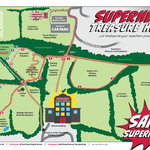Overview
Sam was tragically struck down with FIRES (Febrile Infection Related Epilepsy Syndrome) and did not survive. He had no underlying conditions, and was a healthy and fun loving child, who was exceptionally kind with a huge thirst for learning.
FIRES is the explosive onset of super refractory status epilepticus, which does not respond to appropriate medications. In simple terms it is prolonged seizure activity, or repeated seizures without recovery in between, in someone who does not have active epilepsy. It is not a diagnosis, as the underlying reasons for the FIRES is unknown. However, it is believed to be caused by an autoimmune response to a general virus, or infection. FIRES is simply a description of the symptoms someone is presenting with. We believe Sam had an exceptionally rare autoimmune reaction to a cold, and he sadly had a ONE in a MILLION change of developing it.
- Awareness of FIRES is extremely low amongst not only the public but many medical professionals.
- Children, or adults who have FIRES generally do not come out of this unscathed, their disabilities are life-changing, and it strikes out of the blue in previously healthy children/people. It is the most horrific and catastrophic syndrome, which seems to fade into the background of other childhood illnesses. We are proud that we will have a dedicated section on our website for FIRES awareness, and we will also give a voice to families who have been effected by it by publishing their stories.
- FIRES is a subcategory of NORSE (New Onset Refractory Status Epilepticus).
- Based in America is the NORSE Institute click here, and their mission is to increase awareness of NORSE by "stimulating, integrating and supporting NORSE research; and developing a shared community of NORSE researchers and families". Sam's Superheroes are engaging with the Norse Institute to see how we can support this mission in our own small way.
- Please be aware that this section of our website is still in development. As you can imagine, FIRES and NORSE is a complex subject, and we are not medical experts. But what we can do is pull together information to build awareness and we can sign post back to groups and organisations who are the subject matter experts.
- We will also be giving a voice and a platform to families who have been effected by FIRES, as we have a dedicated section on our website allowing them to share their stories
Refences: The Epilepsy Foundation (click here) National Organisation for Rare Diseases (NORD) (click here) and the NORSE Institute click here.
The Epilepsy Foundation
Describes FIRES as the following:
FIRES is the explosive onset of super refractory status epilepticus. That means a previously well child is having back-to-back seizures that continue or recur for 24 hours or more.
Most children are admitted to the ICU, often for several weeks, for management of severe seizures.
This event is almost immediately followed by the development of chronic epilepsy.
Children with FIRES have a relatively minor infection with fever 2 weeks to 24 hours before the onset of severe, recurrent seizures. Fever might not be present when seizures begin.
The majority of children are left with varying degrees of developmental disability.
- It is sometimes also called febrile illness-related epilepsy syndrome and was previously called fever induced refractory epileptic encephalopathy in school-aged children.
- It usually affects school-aged children with an average age of 8 years old. However, age can range from 2 years to early adulthood.
- Boys are slightly more commonly affected.
- FIRES affects a previously healthy child after a brief, nonspecific febrile (fever) illness, such as a cold or flu.
- Seizures typically start 24 hours to 2 weeks after the illness begins. Fever might not be present when seizures start.
- Seizures are usually focal (affecting one part of the body) but become more frequent with altered awareness between events. Seizures evolve to continuous or nearly continuous seizure activity, which is called status epilepticus. They respond poorly to most medications.
- The initial, acute phase of status epilepticus can last up to 2 weeks or longer.
- FIRES is considered a subcategory of NORSE - new onset refractory status epilepticus.
- FIRES is a very rare condition and affects approximately 1 in a million children.
The National Organisation for Rare Diseases (NORD)
NORD defines FIRES as the following:
Febrile infection-related epilepsy syndrome (FIRES) is a subcategory of new-onset refractory status epilepticus (NORSE) that requires a prior febrile infection starting between 2 weeks and 24 hours prior to onset of refractory status epilepticus, with or without fever at onset of status epilepticus.
New-onset refractory status epilepticus (NORSE) is defined as a condition, not a specific diagnosis, with new onset of refractory status epilepticus without a clear acute or active structural, toxic or metabolic cause in a patient without active epilepsy. Status epilepticus (SE) is a condition of prolonged seizure activity or repeated seizures without full recovery in between. Status epilepticus that persists despite at least two standard anti-seizure medications is termed refractory status epilepticus (RSE). Most of the common causes of RSE can be identified within 24-72 hours of presentation.
In up to half of the cases of NORSE, a possible or probable cause is ultimately found, most often autoimmune or paraneoplastic encephalitis, with infectious causes less common. In the remaining half or more, no cause is identified despite an extensive work-up. These cases are referred to as cryptogenic NORSE or NORSE of unknown etiology. In cryptogenic cases, and likely in other cases, seizures are thought to be caused or exacerbated by an excess of pro-inflammatory molecules in the brain, perhaps triggered by a typical minor infection in a susceptible individual, although no clear cause—or even risk factor–has been demonstrated. Affected individuals are most often treated for weeks in an intensive care unit because they require prolonged anesthesia with coma-inducing drugs to control their seizures. NORSE carries a high rate of complications and mortality, but a significant proportion of patients do eventually recover. Epilepsy (a life-long predisposition to unprovoked seizures), cognitive and psychological issues are common among survivors although a minority of them eventually return to a normal lifestyle.
NORSE Institute
The NORSE Institute defines NORSE and FIRES as
NORSE is a clinical presentation, not a specific diagnosis, in which healthy people are suddenly struck by prolonged seizures that do not respond to at least two anti-seizure drugs and do not have a clear structural, toxic or metabolic cause.
FIRES, is a sub-category of NORSE. There is no age limitation for NORSE or FIRES. Adults can have FIRES and children can have NORSE.
What is NORES
NORSE is the abbreviated term or acronym for new onset refractory status epilepticus. In everyday language, it is a life-threatening condition requiring emergency treatment that comes seemingly from out of the blue (new onset), characterized by a prolonged seizure or a cluster of seizures without recovery in between (status epilepticus) without clear cause despite extensive medical testing. The seizures do not respond to the first and second lines of established medical treatments (refractory). Although the cause for the illness is eventually found in about half the cases (usually autoimmune or paraneoplastic encephalitis), in the balance of the cases, the cause is never found and is often termed “cryptogenic” NORSE or NORSE of unknown etiology.
After at least two anti-seizure drugs fail to stop the seizures, patients are typically placed in a coma with anesthetic drugs to protect their brains from the effects of the seizures (often referred to as a medically-induced coma). The hope is that after this period of quiet, the brain has calmed. At some point, doctors carefully reduce the anesthetic drugs, checking for the return of seizures, a process sometimes referred to as "weaning" the patient away from the anesthetics.
The consequences of NORSE vary from rare, full recovery, to mild to significant neurological deficits (morbidity) and death (mortality). Most survivors require extensive rehabilitation therapy and develop epilepsy despite no previous history of epilepsy.
NORSE Vs FIRES
FIRES, is a subtype of NORSE that is preceded by a fever. (Article of proposed definitions is here.)
Important: FIRES is not the same as simple febrile seizures common in childhood which are considered benign and self-limiting. Previously, the term NORSE was used to refer to new onset refractory status epilepticus in adults, and the term FIRES was referred to the same condition in children. The thinking set forth in the newly-proposed definitions of NORSE and FIRES is that there are no age limits to either condition. Children can have NORSE and adults can have FIRES. Everyone with FIRES, by definition, also has NORSE. The distinguishing characteristic of FIRES is a fever starting between 2 weeks and 24 hours prior to the onset of refractory status epilepticus. NORSE has been observed in all ages but is seen predominantly in young adults and children.
FIRES had been considered a separate entity from NORSE until recently. Even though the proposed consensus definitions linking the two and placing FIRES as a subtype of NORSE have been published and reviewed and endorsed by the Critical Care EEG Monitoring Research Consortium, the diffusion of information is slow. There are still physicians who have never heard of NORSE or FIRES; there are physicians who still think FIRES occurs only in children.
.png)




